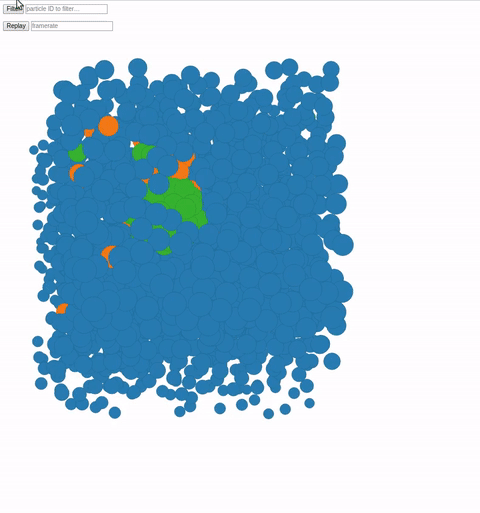Dissipative Particle Dynamics (DPD) Visualiser
0.0.1
This is a DPD visualiser that uses a standard POETS JSON format for bead position and velocity. The aim is to build this repository into a standard interface for all POETS based DPD simulators. The current visualiser is a javascript web-based interface (see above) that uses d3.js to render the particle positions in a 3D space.
It currently has the following features:
- filtering of particle type
- real-time display of the current simulation
- speed up playback of the current simulation from the start
- speed up playback of a previously completed simulation
During playback the (toroidal) 3D space can be rotated, moved around, and dynamically filtered for inspection.
usage
Interfacing with the visualiser is done via a UNIX pipe and JSON files, for example:
./yoursim | nodejs dpd-vis/visualiser.jsWhere yoursim is a dpd simulator and dpd-vis/visualiser.js is the visualiser from this repo.
Along the unix pipe a stdout message "u" indicates that a new JSON state file is ready to read to update the visualiser with new bead positions. This JSON file needs to conform to the format described below.
JSON format
This JSON file captures the state of the simulation at any given moment in time. To do this it needs to describe, each bead id, the position <x,y,z> of each bead, the velocity of each bead <vx,vy,vz>, and the type of each bead (for colouring). The current JSON format looks like the following:
{
"beads":[
{"id":0, "x":10.0865, "y":4.74095, "z":9.41798, "vx":0.0219849, "vy":0.0437972, "vz":0.111897, "type":0},
{"id":1, "x":9.59185, "y":10.9292, "z":2.36002, "vx":0.0577424, "vy":-0.0583262, "vz":-0.0547249, "type":1},
{"id":2, "x":8.02985, "y":5.49861, "z":6.16524, "vx":-0.0968982, "vy":0.0434639, "vz":0.0509043, "type":2}
]
}
In the future we will probably want to add another JSON section that contains some more details about the simulation parameters, such as K_{B}T or the particle repulsion parameters, etc...
configuration
A config.json file needs to be specified to tell the visualiser the following:
- the name of JSON output from your simulation specifying the particle positions
- the location where frames of your state JSON files will be stored for playback
Typically this looks something like the following:
{
"frames" : "_frames",
"state": "state.json"
}install requirements
The following must be installed in order to use the visualiser
apt-get install npm
apt-get install nodejsTODO list
- Make the particle filtering easier (using radio buttons or something) so that you don't have to remember the numerical particle type
- Move the filer stuff and the playback stuff to the right hand side in a control panel
- test out opacity reduction instead of setting the fill to empty when filtering particles
changelog
- 0.0.1 - initial release
